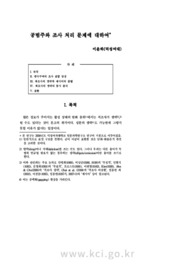

-
미리보기
서지정보
· 발행기관 : 한국문법교육학회
· 수록지 정보 : 문법 교육 / 21권 / 239 ~ 263페이지
· 저자명 : 이창덕
초록
In Korean education, as in any language education system, there are complicated grammatical and contextual concepts requiring in depth explanations, for example, the difference between tense and aspect, and between subject and topic. It is very challenging for teachers to respond effectively to students' question on precise meanings and usage in context when even linguists have not resolved yet these issues.
In this paper, I systemize precisely 'subject' and 'topic' in current Korean usage, and offer a method to explain the meaning and function of the particles ‘-이/가’and ‘-은/는’. I also propose that the concept of 'subject' and 'topic' should be viewed from entirely different perspectives.
In the last few decades "subject' has been studied in syntax as a significant constituent acting as an agent with the predicate of a sentence. However, strictly speaking, 'topic' is not a notion of syntactic structure but of pragmatic usage in practical conversation contexts. Therefore, the particle ‘-이/가’ should be dealt with not only syntactically but also from a pragmatic perspective. The particle ‘-이/가’ is used for the maker of the subject at sentence level but at the pragmatics level it definitely has the function of 'focus (comment, new information)'. Also, the particle ‘-은/는’ is not a case maker at sentence level but a special particle with the meaning of 'contrast'. At the pragmatic level, except as a maker of 'contrast', the particle ‘-은/는’ is the topic marker (given, old information)' that has been identified between the speaker and the hearer with appropriate conditions in some contexts.
In conclusion, in Korean language education, the notions 'subject' and 'topic' should be taught as different conceptions of different domains, and the particles ‘-이(-i)/가(ga)’ and ‘-은(eun)/는(neun)’ should also be considered at both the syntax and pragmatics levels. The particle ‘-이/가’ is a 'focus' marker (comment, new information)' as well as a subject marker. The particle ‘-은/는’ is a special particle with the meaning of 'contrast' in syntax and also the marker of 'topic(given, old information)' in pragmatics.영어초록
In Korean education, as in any language education system, there are complicated grammatical and contextual concepts requiring in depth explanations, for example, the difference between tense and aspect, and between subject and topic. It is very challenging for teachers to respond effectively to students' question on precise meanings and usage in context when even linguists have not resolved yet these issues.
In this paper, I systemize precisely 'subject' and 'topic' in current Korean usage, and offer a method to explain the meaning and function of the particles ‘-이/가’and ‘-은/는’. I also propose that the concept of 'subject' and 'topic' should be viewed from entirely different perspectives.
In the last few decades "subject' has been studied in syntax as a significant constituent acting as an agent with the predicate of a sentence. However, strictly speaking, 'topic' is not a notion of syntactic structure but of pragmatic usage in practical conversation contexts. Therefore, the particle ‘-이/가’ should be dealt with not only syntactically but also from a pragmatic perspective. The particle ‘-이/가’ is used for the maker of the subject at sentence level but at the pragmatics level it definitely has the function of 'focus (comment, new information)'. Also, the particle ‘-은/는’ is not a case maker at sentence level but a special particle with the meaning of 'contrast'. At the pragmatic level, except as a maker of 'contrast', the particle ‘-은/는’ is the topic marker (given, old information)' that has been identified between the speaker and the hearer with appropriate conditions in some contexts.
In conclusion, in Korean language education, the notions 'subject' and 'topic' should be taught as different conceptions of different domains, and the particles ‘-이(-i)/가(ga)’ and ‘-은(eun)/는(neun)’ should also be considered at both the syntax and pragmatics levels. The particle ‘-이/가’ is a 'focus' marker (comment, new information)' as well as a subject marker. The particle ‘-은/는’ is a special particle with the meaning of 'contrast' in syntax and also the marker of 'topic(given, old information)' in pragmatics.참고자료
· 없음태그
-
자주묻는질문의 답변을 확인해 주세요

꼭 알아주세요
-
자료의 정보 및 내용의 진실성에 대하여 해피캠퍼스는 보증하지 않으며, 해당 정보 및 게시물 저작권과 기타 법적 책임은 자료 등록자에게 있습니다.
자료 및 게시물 내용의 불법적 이용, 무단 전재∙배포는 금지되어 있습니다.
저작권침해, 명예훼손 등 분쟁 요소 발견 시 고객센터의 저작권침해 신고센터를 이용해 주시기 바랍니다. -
해피캠퍼스는 구매자와 판매자 모두가 만족하는 서비스가 되도록 노력하고 있으며, 아래의 4가지 자료환불 조건을 꼭 확인해주시기 바랍니다.
파일오류 중복자료 저작권 없음 설명과 실제 내용 불일치 파일의 다운로드가 제대로 되지 않거나 파일형식에 맞는 프로그램으로 정상 작동하지 않는 경우 다른 자료와 70% 이상 내용이 일치하는 경우 (중복임을 확인할 수 있는 근거 필요함) 인터넷의 다른 사이트, 연구기관, 학교, 서적 등의 자료를 도용한 경우 자료의 설명과 실제 자료의 내용이 일치하지 않는 경우
“문법 교육”의 다른 논문도 확인해 보세요!
-
웹 검색을 이용한 맞춤법 오류의 변화 양상 연구 - 사이시옷 표기를 중심으로 27 페이지
This experiment is about investigating Saisiot written condition, analyzing it and finding the problem with writing Saisiot. Meantime, the research to spelling errors has been conducted with the metho.. -
한국어교육용 초급 어휘 선정 연구 26 페이지
The purpose of this study is to select a beginner level of Korean language vocabulary and construct education contents for the general purpose Korean learners, which serve as a foundation for effectiv.. -
형태소의 ‘자립성’과 ‘의존성’에 대한 학습자의 오개념 연구 38 페이지
The purpose of this study is to examine learners’ misconceptions about ‘free’ and ‘bound’ morpheme and to propose an educational direction. Learners’ misconceptions such as “wrongly associating free m.. -
존대 형태소 ‘-시-’의 의미와 문법 21 페이지
The basic and general understanding about Korean honorific morpheme ‘-si-’ is that it is subject honorific expression. But all the usages of it do not agree with this general conception. Namely, it se.. -
‘-었-’ 관련 특수 활용 형용사에 대한 연구 25 페이지
The purpose of this paper is to find out the list of Adjectives which inflect specially in Korean language. And another purpose is to explain the reasons why some Adjectives not inflect as general Kor..
찾으시던 자료가 아닌가요?
지금 보는 자료와 연관되어 있어요!
문서 초안을 생성해주는 EasyAI



